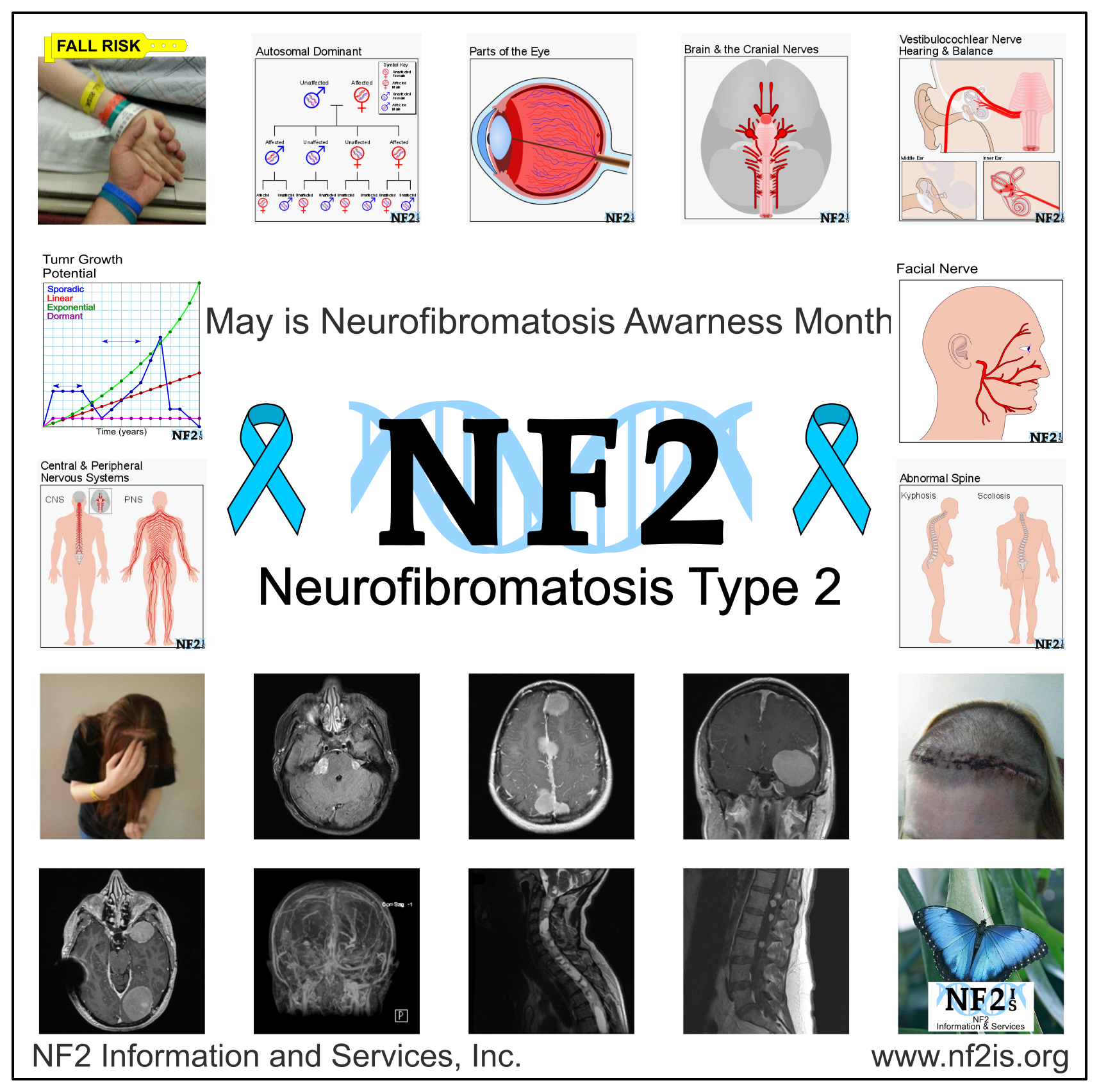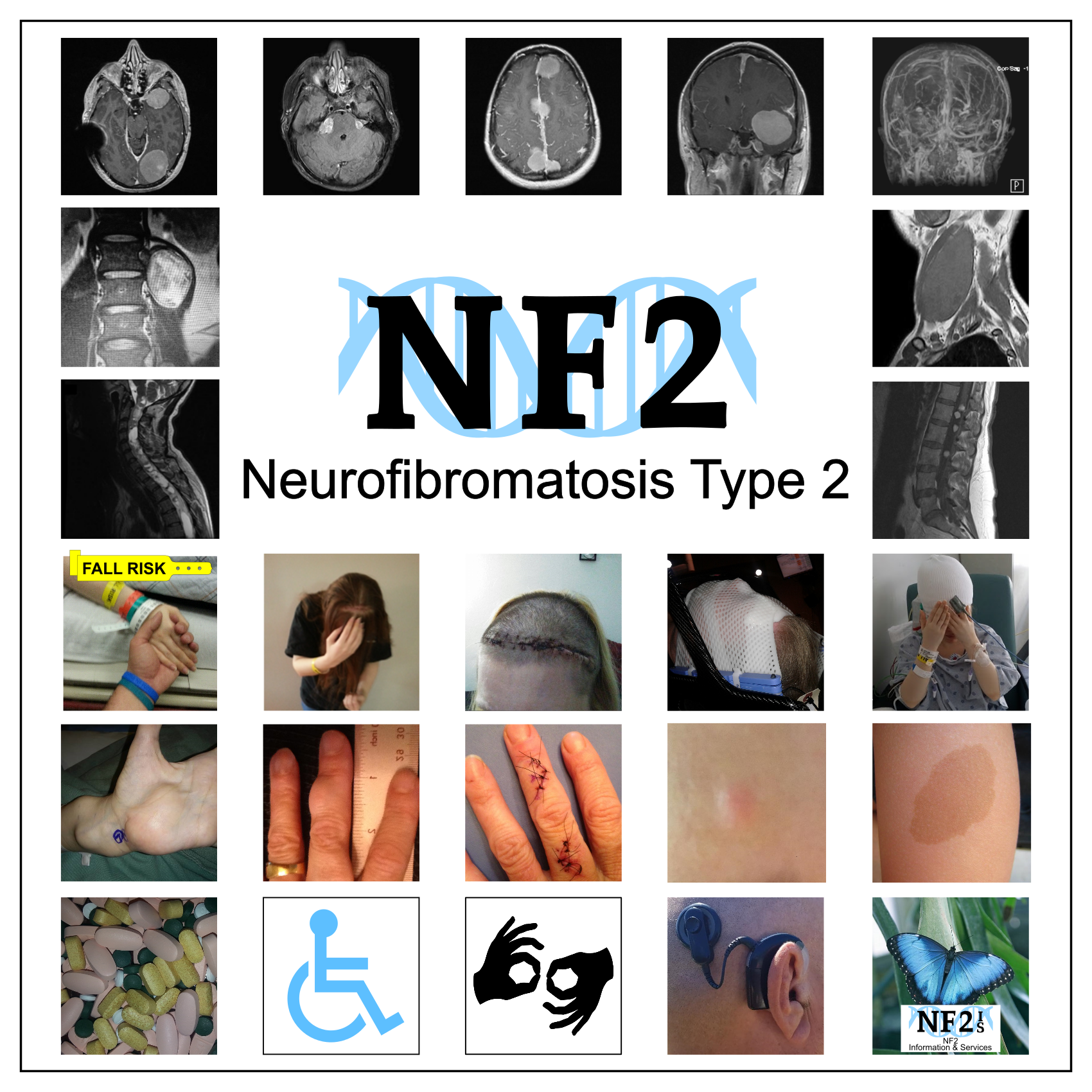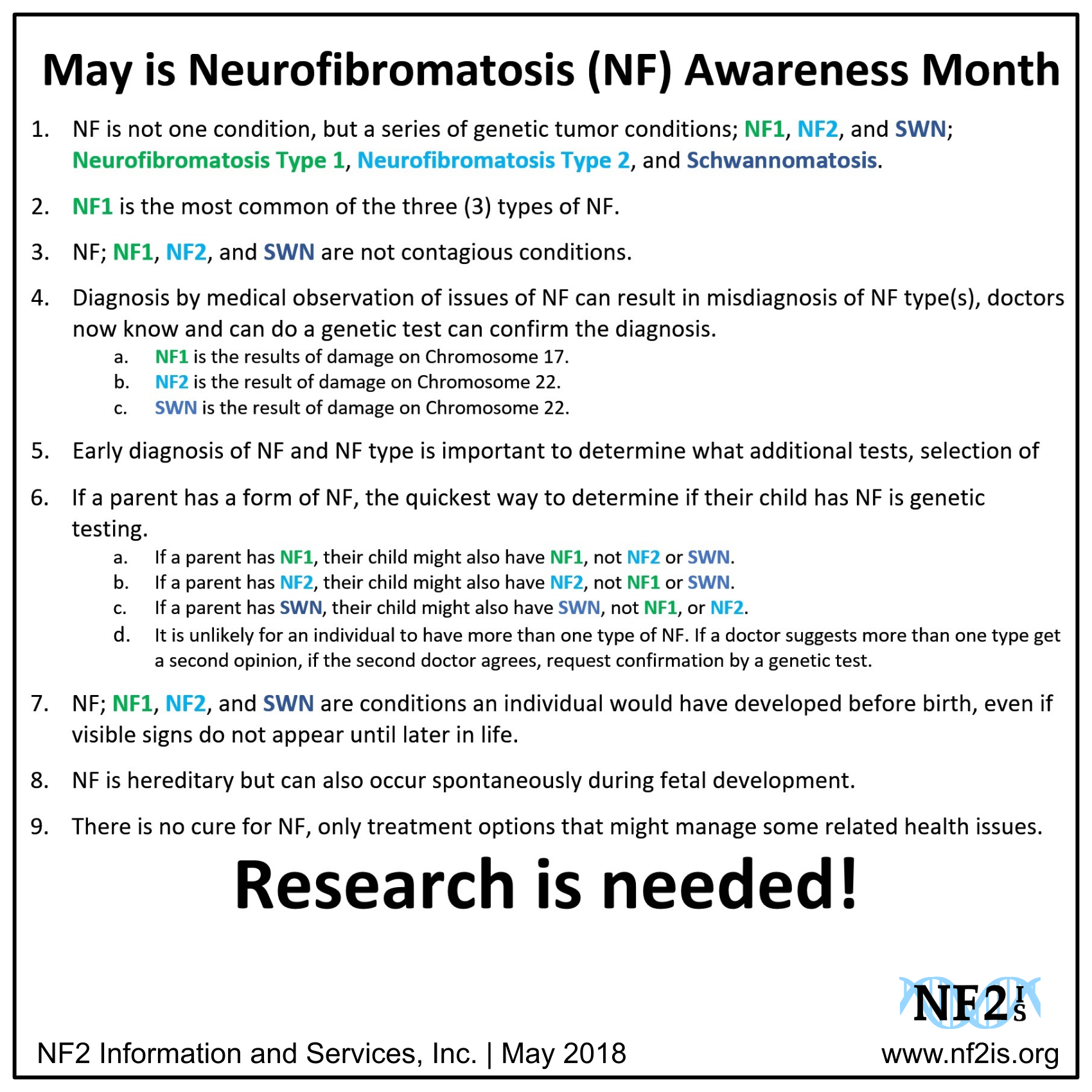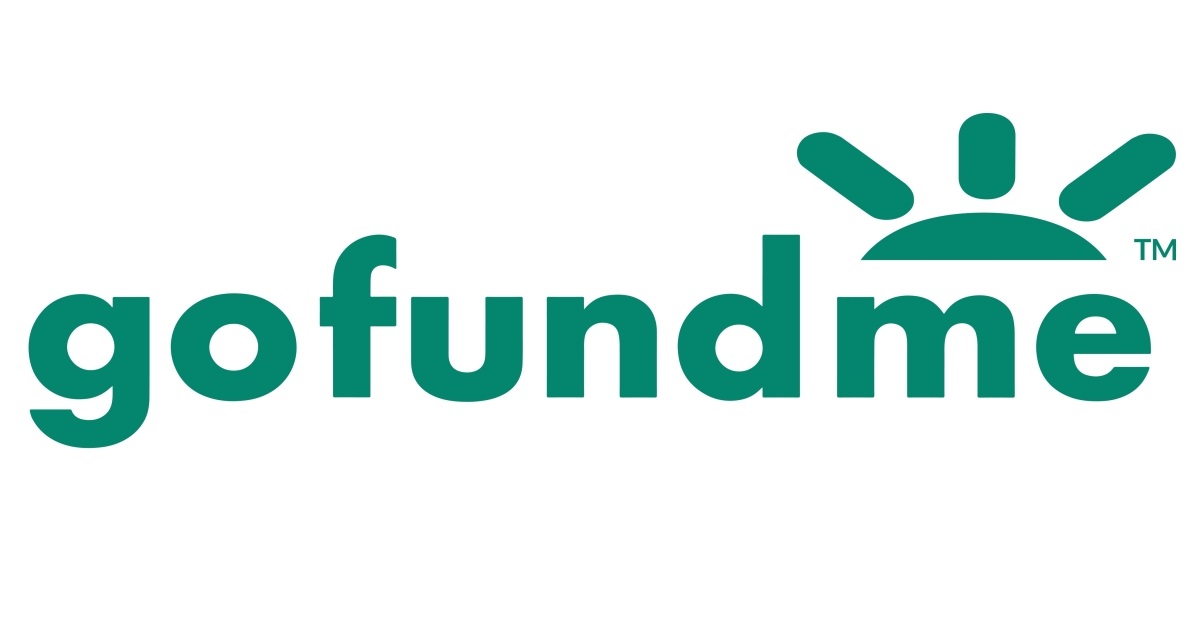Home > Fundraiser Ideas >
Neurofibromatosis Awareness: 2018
Last Updated: 05/7/19
Index
- Neurofibromatosis (NF) Facts: Graphic Format
- Neurofibromatosis (NF) Facts: Text Format
- NF Information from 2017
- Disability and Observance Awareness
Months and Days: (jump)
Reminder: May is Neurofibromatosis Awareness, NF Awaeness Month.
NF1 Day is May 17th: Neurofibromatosis Type 1 (NF1) is a condition that develops because of damage to Chromosome 17.
NF2 Day is May 22nd: Schwannomatosis are a conditions which develops because of damage to Chromosome 22.
Some days more than one share was included to cover the multiple NF types better. The date is included on images and facts since what is known as statistics and research has changed understandings of facts over time.
Example: NF2 the hallmark tumors were initially called Acoustic Neuroma (AN) when Cranial Nerve 8 (CN8) was known as one nerve. When doctors learned CN8 branched into the Cochlea for hearing and Vestibule for balance, the tumor was officially renamed to Vestibular Schwannoma (VS). Not a change of facts but revision based on science developments.
Note: There is a considerable amount of misinformation about the three different NF type from what was understood before genetic testing. Always note dates on sources information about NF; NF1, NF2, SWN/NF3 is obtained from.
1. Neurofibromatosis (NF) Facts: Graphic Format

|

|

|
2. Neurofibromatosis (NF) Facts: Text Format
Basic Fact Sheet
- NF is not one condition, but a series of genetic tumor conditions; NF1, NF2, and SWN; Neurofibromatosis Type 1, Neurofibromatosis Type 2, and Schwannomatosis.
- NF1 is the most common of the three (3) types of NF.
- NF; NF1, NF2, and SWN are not contagious conditions.
- Diagnosis by medical observation of issues of NF can result in misdiagnosis of NF type(s), doctors now know and can do a genetic test can confirm the diagnosis.
- NF1 is the results of damage on Chromosome 17.
- NF2 is the result of damage on Chromosome 22.
- SWN is the result of damage on Chromosome 22.
- Early diagnosis of NF and NF type is important to determine what additional tests, selection of possible treatments, and other help.
- If a parent has a form of NF, the quickest way to determine if their child has NF is genetic testing.
- If a parent has NF1, their child might also have NF1, not NF2 or SWN.
- If a parent has NF2, their child might also have NF2, not NF1 or SWN.
- If a parent has SWN, their child might also have SWN, not NF1, or NF2.
- It is unlikely for an individual to have more than one type of NF. If a doctor suggests more than one type get a second opinion, if the second doctor agrees, request confirmation by a genetic test.
- NF; NF1, NF2, and SWN are conditions an individual would have developed before birth, even if visible signs do not appear until later in life.
- NF is hereditary but can also occur spontaneously during fetal development.
- There is no cure for NF, only treatment options that might manage some related health issues.
Inheritances of Neurofibromatosis: 05/05/18
Neurofibromatosis (NF) consists of three types: Neurofibromatosis Type 1 (NF1) , Neurofibromatosis Type 2 (NF2) , and Schwannomatosis (SWN/NF3) .
- The NF conditions are autosomal dominant; conditions that can be passed mother or father to son or daughter.
- NF can also occur spontaneously where neither mother or father had NF. Reason unknown, more research is needed. Development may occur either;
- Germline where a parent's egg or sperm did not include the NF gene or otherwise damaged, or
- Mosaic where the development of damage occurs early in fetal development.
- Individuals with Mosaic NF may have a mild form of NF when compared to the next generation.
- Individuals with inherited NF1 and inherited NF2 have a 50% chance to pass NF to the next generation.
- Individuals with mosaic NF1 or mosaic NF2 have a 33% chance to pass NF to the next generation.
- It is unknown how SWN can skip generations, more research needed.
- NF can only be passed from parent to child as it is genetic and not contagious.
- Tumor type most common for NF1 is Neurofibroma.
- Tumor type most common for SWN is Schwannoma.
- Tumor types most common for NF2 are Schwannoma, Meningioma, and Ependymoma.
- Neurofibroma and Schwannoma grow as parts of nerves. The difference between the two tumor types cannot be seen in an MRI but would require a tumor biopsy after surgery.
- Individuals with NF1 and NF2 also develop issues unrelated to tumor growth.
Neurofibromatosis Tumors: 05/07/18
- Neurofibromatosis Tumors of Neurofibroma and Schwannoma are nerve-damaging masses. These tumors can result in; muscle, sensory, or organ issues depending on the nerve and the point of the nerve the mass grows.
- The majority of Neurofibromatosis Tumors are Benign (Noncancerous), even if with growth any tumor can become Malignant (Cancerous).
- Due to the number of tumors an individual with NF may have, tumors are often not treated until an issue arises. Not all possible issues would be found without an MRI. Extended breaks in MRI's can have dangerous results.
NF2 Hearing/Balance (VS): (05/01/18)
Definitions
- Neuroma: nerve tumor
- Schwannoma: nerve tumor; overgrowth of schwann cell
- Cochlear Nerve: previous name Acoustic Nerve
- Cranial Nerve 8 (CN8): includes two branches cochlear nerve (hearing) and vestibular nerve (balance)
- Bilateral: having or relating to two sides; affecting both sides.
Facts
- The Neurofibromatosis Type 2 (NF2) hallmark issue is tumor growth of schwannoma tumors bilaterally along Cranial Nerve 8 (CN8).
- NF2 hallmark tumors were previously known only as Acoustic Neuroma (AN), but the term Vestibular Schwannoma (VS) is more accurate and likely. But:
- Now NF2 tumors are known as schwannoma since we know their growth is not just on nerves but as overgrowths of nerves schwann cell.
- The initial name of Cochlear Nerve was the Acoustic Nerve.
- Unknown information that a part of CN8 was a branch for balance not just hearing; eventually named Vestibular Nerve.
- Schwannoma, both from NF2 and spontaneous schwannoma growths (people without NF2), are more likely to grow on the vestibular nerve branch of CN8.
- Individuals with NF2 the hallmark tumors are not just likely to grow bilaterally, but it is possible and common for multiple schwann cell overgrowths along CN8. With early surgical or radiation intervention, more treatment may be necessary again years later.
- There is no way to know how many Schwannoma will develop along CN8 and early treatment intervention of either radiation or surgery could easily result in a need to have treatment again years later.
- MRIs should assume clarity enough to see the tumor mass clearly to show how many schwann cell overgrowths.
- Schwannoma masses may look like a bundle of grapes in clear MRI scans and during surgery. Possible inability to identify the exact number of schwannoma in a cluster is part of the reason sometimes radiation treatment does not always seem to work for NF2 tumors.
Neurofibromatosis: Unseen Pain (05/10/18)
Neurofibromatosis Type 1 (NF1), Neurofibromatosis Type 2 (NF2), and Schwannomatosis (SWN/NF3). The three NF types are completely different, but many people with each fight constant or long periods of pain.
There are extreme differences in the NF types but one commonality is not all pain experienced is the results of hidden pain. Pain the results of damage that mrequires nerve tests or MRI to see, and some pain tests will not find.
Pain from brain tumor burden, body nerve pain, organ issues, not all NF issues can be seen in a photo or meeting someone in person.
Since some issues that cause pain cannot be seen from the skin surface, it can be a deterrent from getting help, not just in pain medication, but in treatments to stop the cause of the pain.
Neurofibromatosis: Brain Deficit and Trauma (05/11/18)
Individuals with NF are at risk of brain-related issues: with Neurofibromatosis Type 1 (NF1), there is a risk of a brain deficit at birth, but anyone who has tumor growth is at risk of Traumatic Brain Injury (TBI). TBI would be the reason an individual with either Neurofibromatosis Type 2 (NF2) or Schwannomatosis (SWN/NF3) could be at risk of memory or confusion issues.
Neurofibromatosis Type 1 (NF1)
About 50% of individuals with NF1 are born with a brain deficit to the posterior cingulate cortex (PCC) that causes; Childhood Learning Issues (visuospatial abilities) and either Attention-deficit with or without Hyperactivity Disorder (ADHD).
Issues may include:
- Reverse letters
- Have problems with positioning objects in space
- Difficulties distinguishing subtle differences between similar sounds
- Misunderstand social cues and body language
- Problems putting things in an order that makes sense
- Trouble figuring out the meaning of symbols and words
- Difficulty in organizing new information
Definition
Visuospatial Abilities = a person's capacity to identify visual and spatial relationships among objects.
Neurofibromatosis Type 2 (NF2) and Schwannomatosis (SWN/NF3)
Individuals with NF2 or NF3/SWN are not born with brain dysfunction. Individuals with NF who develop brain tumors which is most likely with NF2 are at risk of temporary or long-term Traumatic Brain Injury (TBI). TBI can develop as a result of; 1) Brain Tumor Growth, 2) a Stroke, 3) Brain Tumor Surgery, 4) Tumor Radiation/Radiotherapy treatments (Gamma Knife, CyberKnife, or Proton Therapy), or 4) in the event of rapid tumor change from a clinical tumor-drug treatment. Recovery from tumor removal is likely more complete than radiation-based treatments.
- Confusion
- Trouble Concentrating
- Mental Fog
- Memory loss; names, dates, or numbers
- Impaired; math, organizational, and language
- Problems Multitasking
- Exact issues an individual may face is dependent on tumor locations, could cause issues with the movement of different parts of the body or vision.
Other things that can result in ADHD
If a woman takes Acetaminophen during pregnancy, the child is at risk of ADHD.
Learn More
- Washington University in St. Louis. NF Center. "Learning and Attention Deficits" https://nfcenter.wustl.edu/what-is-nf/neurofibromatosis-type-1/learning-attention-deficits/
- NF2 Information and Services, "Brain Matter" (2017) https://www.nf2is.org/brain_matter.php
Cafe Spots (CALMS) (05/12/18)
Cafe-au-lait Marks (CALMS) or simply Cafe Spots can be dark brown, or light brown, contrast areas of different skin pigmentation, and maybe about one inch in diameter (1").
Often such a mild difference in skin tone they may be unnoticed or difficult to see in pictures. Presence of Cafe Spots on an individual is a sign the individual has a genetic condition. Physical examination of cause is important. These can also fade over the years. No treatment is necessary.
If an individual in a family has Neurofibromatosis (NF); Neurofibromatosis Type 1 (NF1), Neurofibromatosis Type 2 (NF2), or Schwannomatosis (SWN/NF3) also develop these marks, medical review for further tests to confirm if the child has NF1, NF2 or SWN.
- Ataxia Telangiectasia
- Basal Cell Nevus Syndrome
- Bloom Syndrome (BS) or Bloom-Torre-Machacek syndrome
- Chediak-Higashi syndrome
- Fanconi Anemia
- Gaucher Disease
- Hunter Syndrome
- Legius Syndrome or NF1-Like-Syndrome
- Maffucci Syndrome or Hunter Syndrome
- McCune-Albright Syndrome (MAS)
- Multiple Mucosal Neuroma Syndrome
- Russell-Silver syndrome (RSS) or Silver-Russell syndrome (SRS)
- Tuberous Sclerosis Complex (TSC)
- Watson Syndrome
Neurofibromatosis: Family Planning (05/14/18)
Having children can be complicated for individuals with Neurofibromatosis (NF), people with Neurofibromatosis Type 1 (NF1), and Neurofibromatosis Type 2 (NF2), but not for Schwannomatosis (SWN/NF3). Individuals with NF1 and NF2 are at risk of health issues earlier in life than individuals with SWN since people with SWN typically do not have tumor issues until the fourth decade of life.
A risk of the many medications taken to help manage health issues for NF1 and NF2 is an inability to have children, now more than ever. Please help raise awareness of these issues for steps to be taken for a healthier next generation.
Risks
- Infertility: All tumor-drug treatments in Clinical Trials risk a female's ovaries and eggs and can result in infertility with early menopause. Some of these medications result in longer menstrual cycle duration from twenty-eight days to months, within the first two months of treatment. [1]
- Miscarriage: Some medications taken can result in miscarriage if taken while a female is pregnant, like epilepsy medications and antidepressants. [2]
- Other Side Effects: Possible risk of not just passing NF but additional health issues as a result of the combination of medications taken early in life. [3]
- Tumor Growth: The choice to not have children due to possible risk of tumor growth during pregnancy. Some women died either immediately or within a few days following birth to a child as a result of tumor growth from pregnancy. [4,5,6]
- Males make sperm regularly, but medications taken can remain in the body for a few months to potentially risk passing damaged sperm.
- Inherited NF: Individuals with NF1 and NF2 have a 50% chance of passing their NF type to their child.
Consider
- Taking to a geneticist
- Have hope while we wait for better treatment options for the future and consider freezing eggs for possible reimplantation later in life or a surrogate.
- There are blood tests females should take while taking tumor-drug treatments that would note ovarian health which can help in determining if discontinuing the treatment is something they need to do.
- Adoption.
Sources
- NF2 Information and Services. "Tumor-Drug Treatments and Premature Ovarian Failure." https://www.nf2is.org/pof.php
- Epilepsy Foundation of America. "Seizures, Medications and Pregnancy." https://www.epilepsy.com/living-epilepsy/women/epilepsy-and-pregnancy/seizures-medications-and-pregnancy
- WebMd. "Acetaminophen in Pregnancy Tied to ADHD Risk." (2016) https://www.webmd.com/add-adhd/childhood-adhd/news/20171030/acetaminophen-in-pregnancy-tied-to-adhd-risk#1
- NF2 Information and Services. "NF2 Tumor Growth." https://www.nf2is.org/increased_tumor_growth.php
- NF2 Information and Services. "Pathophysiology of Meningioma Growth Risks." https://www.nf2is.org/meningioma.php
- Tibor Hortobagyi, Janos Bencze, et al. DeGruyter "Pathophysiology of Meningioma Growth in Pregnancy and other Growth Risks" (2017) https://www.degruyter.com/downloadpdf/j/med.2017.12.issue-1/med-2017-0029/med-2017-0029.pdf
Kidney Issues (Renal Failure) (05/17/18)
Not all health issues from Neurofibromatosis (NF); NF1, NF2, and Schwannomatosis (NF3/SWN) are not the result of tumors. Some health issues are the results of long-term use of different treatments to manage NF in some way.
Individuals with Neurofibromatosis (NF) are a high risk of Kidney Issues (Renal Failure). Top three reasons include:
- Scan Contrast Agent for MRI - Gadolinium (Gd)
- Drug-based Tumor Treatments
- Pain Medication: Ibuprofen (Motrin)
1. MRI Contrast Gd
Gadolinium (GD), is the contrast agent used during MRI. Gd is the primary component of all contrast compounds used to improve the visibility of internal body structures for magnetic resonance imaging (MRI). The Gd is required to find tumors during an MRI scan.
Alternative options to Gd are currently in research and may be available in the next few years. MRI scans are important, and longer duration in scans can allow time for tumors to become untreatable.
2. Tumor Drug-Therapies (Clinical Trials)
The Neurofibromatosis (NF) tumor-drug treatments are molecular target tumor treatments. When the drug treatments work, the treatment will either stop the growth or reduce the size of some tumors. These treatments do not result in tumor death. Treatment results last with either continued; daily treatment for the pill trials, or treatment every three-weeks for the Intravenous (IV) treatments like Avastin. These treatments can be taken until the side effects outweigh the advantages of the treatment. One possible side effect is kidney failure.
For individuals taking tumor-drug trials, blood and urine tests should be done to monitor kidney health. Individuals on any drug-based tumor treatment in a clinical trial need blood and urine test monthly to monitor kidney health.
3. Ibuprofen
NF commonly results in debilitating pain for different reasons and Ibuprofen is the first response to pain management, but Ibuprofen can easily result in kidney failure if taken too frequently.
Given the number of MRI scans individuals with NF have done, prescription options for pain should be considered.
Complete Source
NF2 Information and Services. "Kidney Issues (Renal Failure)." (2018) https://www.nf2is.org/kidney_failure.php
Eyes and Vision (05/17/18)
Neurofibromatosis Type 1 (NF1)
For individuals with NF1, vision issues are possible but not common. NF1 vision issues might be from tumor growth on the face which could block the eye, but there is a 15%-20% risk of growth of low-grade Optic Glioma tumors. [1]
Lisch Nodules (Iris Hamartomas) are a common occurrence. Iris Hamartomas are clear, yellow-brown, oval to round, dome-shaped papules that project from the surface of the iris. These nodules typically do not affect vision but are very useful in diagnosis. [2]
Neurofibromatosis Type 2 (NF2)
Many issues can result in poor vision or complete blindness for individuals with NF2. Lack of vision is dangerous given individuals with NF2 have a 98% chance of tumor growth that slowly results in deafness. With either poor vision, or no vision, the requirement of visual cues for balance is less likely. [3]
Individuals may have vision issues for many reasons the most common: [4]
- Juvenile Cataracts Posterior Subcapsular
- Retinal Detachment
- Tumor Growth on or damaging Eye Cranial Nerves
- Papilledema
- Vision Disturbances - Ocular Migraines
- Retinitis Pigmentosa (RP)/Retinal Degeneration
- Severe Dry Eyes
- Nystagmus/Oscillopsia
- Diplopia (Double Vision)
- Eye Dilation Issues
- Light Sensitivity
Juvenile Cataracts or cataracts found in children is a sign of NF2. The normal age of onset of Cataracts is generally over fifty.
Surgery to treat Juvenile Cataracts can easily result in permanent vision loss from Retinal Detachment.
The most common area of the body for NF2 tumors to grow is in the skull along cranial nerves.
The inability for an eye to producing either natural tears as a result of damage to the Facial Nerve (Cranial Nerve 7) or oil secretion from after damage to Trigeminal Nerve (Cranial Nerve 5). If an individual develops a severe dry eye for these reasons, hourly care of adding moisture is required to Prevent Permanent Cornea Damage.
Nystagmus/Oscillopsia is difficulty focusing both eyes and uncontrolled rapid (shaky) eye movement. Common issue following bilateral damage to bilateral hearing and balance nerves.
It is common for one eye to wander as a result of either Nystagmus or growth of a tumor on hearing and balance nerves.
Sources
- NF Center. https://nfcenter.wustl.edu/research/laboratory-research/nf1-optic-pathway-glioma-other-brain-tumor-research
- Kumar, Vinay, et al. "Robbins and Cotran pathologic basis of disease." (2005).
- NF2 Information and Services. "Vestibular Balance Issues" (May 2018) https://www.nf2is.org/balance_issues.php
- NF2 Information and Services. "NF2 Eye Issues." (May 2018) https://www.nf2is.org/eye_issues.php
NF2 Day: Risks, Research, and Education (05/22/18)
- NF Center. https://nfcenter.wustl.edu/research/laboratory-research/nf1-optic-pathway-glioma-other-brain-tumor-research
- Kumar, Vinay, et al. "Robbins and Cotran pathologic basis of disease." (2005).
- NF2 Information and Services. "Vestibular Balance Issues" (May 2018) https://www.nf2is.org/balance_issues.php
- NF2 Information and Services. "NF2 Eye Issues." (May 2018) https://www.nf2is.org/eye_issues.php
NF2 Day: Risks, Research, and Education (05/22/18)
Neurofibromatosis Type 2 (NF2) is a condition which results in health issues as a result of either damage or missing NF2 gene on Chromosome 22q12.
People born with Hereditary NF2 will have tumor growth, depending on how the NF2 gene was damaged will determine how early tumor issues start, the overall general rate of growth and areas of the body tumors are likely to grow.
NF2 Day: Health Issues (05/22/18)
NF2 Day: NF2 and Hearing (05/30/18)
The neurofibromatosis type 2 (NF2) tumors, vestibular schwannoma/acoustic neuroma, result in bilateral deafness and balance issues in 95%-98% of people with hereditary NF2.
Natural hearing alternatives to discuss with doctors:
- Hearing Aids: Sound amplification options.
- Cochlear Implants (CI): An implant that sends sound directly into the cochlea of the ear.
- Auditory Brainstem Implant (ABI): An implant that sends sound directly to the brain following a complete loss of function of the cochlear (hearing) nerve.
- Sound clarity with an ABI implant is not the same as natural hearing.
- The first year after the implant of an ABI, several sessions with an audiologist are necessary for sound adjustments and speech (lip) reading before sound might make sense as speech.
- A factor in sound quality with ABIs is surgeon experience with implanting ABI's in other people.
- Tumor-drug Trial Treatments: Medications in trials can help delay progression of tumor growth for hearing loss for months or years. There is no way to predict if either the drug treatment may work, or will work at all until an individual starts the treatment, and there are signs of tumor reduction.
- Sign Language: It is a good idea to learn basic sign language before changes in hearing. Sign language is not just a set of signs but a complete language. Education of sign language is ideal in person or by video, not pictures or books.
Sources:
- NF2 Information and Services. "NF2 Awareness 2018 - NF2 and Hearing Options"
- NF2 Information and Services. "Hearing Implants." https://www.nf2is.org/hearing_implants.php
- NF2 Information and Services. "Sign Language." https://www.nf2is.org/sign_language.php
- NF2 Information and Services. "NF2 Tumor-drug Trials." https://www.nf2is.org/tumor_suppressors.php


 |Google Play
|Google Play